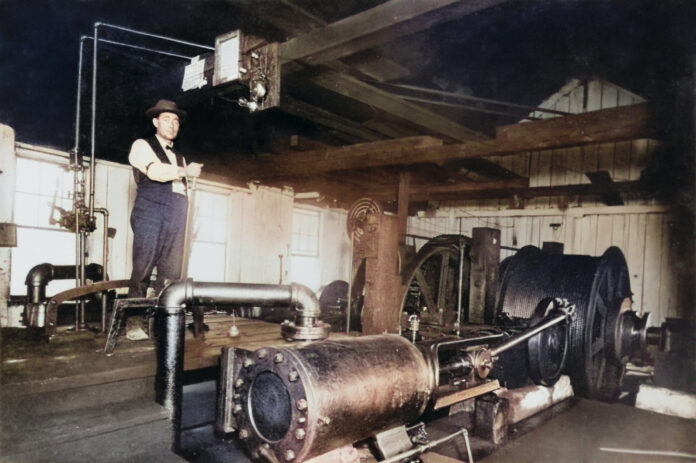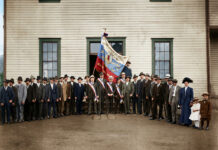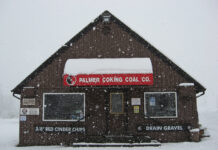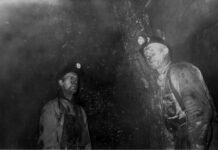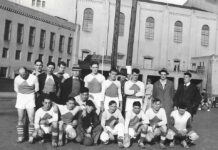Fred Tonkin is shown operating the hoist at a Black Diamond coal mine. The hoist referred to the machinery that pulled and lowered up and down the slope, the tunnel that connected the workings of an underground coal mine to the surface facilities where coal was processed. The hoist-man occupied one of the most important jobs in a mine, so the position was often filled by a seasoned miner who knew the workings of a mine, inside and out. For the lives of his fellow miners were quite literally in his nimble hands. Because at every shift, the hoist-man lowered coal miners down into the mine, typically on special man-cars, and at the end of the day raised them back up to the surface.
The hoist, as seen to the right in the photo was like a giant fishing reel. A thick steel cable, typically about 1” in diameter depending on the degree of cable strength needed, was wound upon a large cylinder. This particular hoist was powered by a steam engine which turned a wheel connected to a pulley that rotated the hoist. A large amount of energy was needed to elevate car loads of coal on steel rails up the steep incline called the slope or entryway into the mine. The top of the slope was called the portal.
The hoist-man couldn’t see what was happening underground, so relied on bell signals relayed from a miner down below. The process was simple – the miner used a device comprised of a wood handle and a metal bar that short-circuits two live, low-voltage wires and produced a ringing bell in the hoist room, similar to a doorbell. Typically, one bell was the signal to raise the loaded coal car, and two bells to lower it. There were also special signals in case of an emergency, or when a miner called the rope rider accompanied the loaded car to the surface.
It’s not entirely visible or clear, but to the right of Fred Tonkin’s waist, there is a circular dial that indicates the coal car’s location along the inclined slope. The hoist-man needed to carefully note the position of the dial to know the exact position of the coal car. As the steel cable stretched or grew worn, the dial was periodically calibrated to the position of the coal car. Each load was called a ‘trip’ as in taking a trip to the surface of the mine.
In 1913, Fred H. Tonkin was elevated to the position of grand chancellor of the Knights of Pythias in the State of Washington. The Knights of Pythias is a fraternal organization that was the first to receive a charter under an act of Congress. Several notable Americans including Louis Armstrong, Nelson Rockefeller, and three presidents have been lodge members. Tonkin was not only a dependable coal miner but was appointed as Black Diamond’s postmaster on Nov. 1, 1923. Back then the post office was in Porenta’s Tailor Shop building, located on the north edge of today’s Black Diamond Eagles Hall. Later his wife, Annetta Tonkin carried on the position when Fred became disabled. Fred was a both prominent mining man and a state representative.
This photo was likely taken in the early 1900s at either Mine No. 14 or Mine 11. It comes courtesy of the Black Diamond History Museum and appeared on page 53 of “Black Diamond: Mining the Memories” by Diane & Cory Olson. Copies of their oral history book are available for sale at the museum. It is a superb introduction to the origins and growth of the coal mining company and town folks who relocated from Nortonville, California to south King County in the mid-1880s. Photo enhancements and colorization were performed by Doug Burham, a Tahoma photography instructor and owner of Boomers Photography in Maple Valley.

